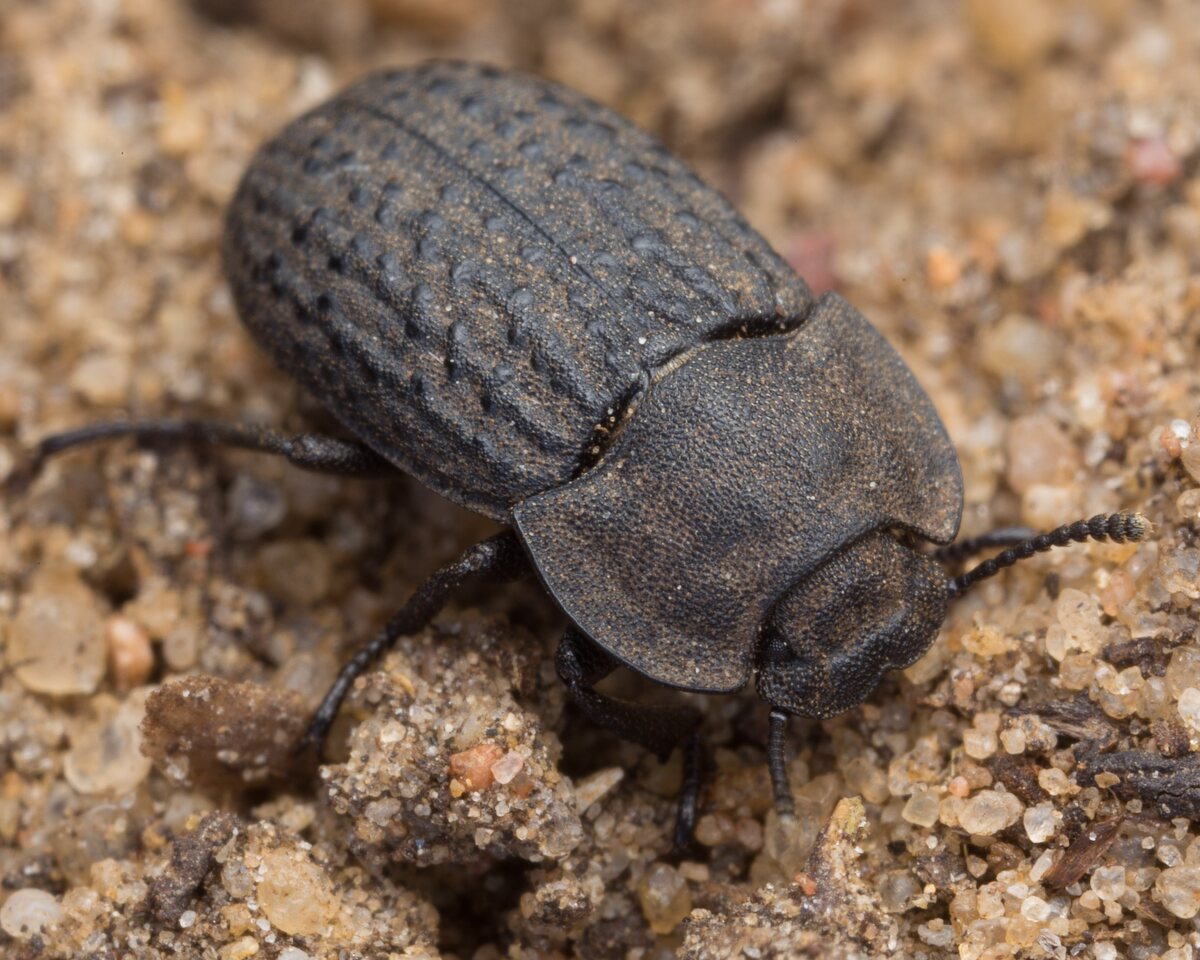
Opatrum sabulosum · smiltyninis juodvabalis
- Almindelig støvskyggebille, Skræntskyggebille
- Gemeine Staubkäfer
- pikkusavipimikkä
- smiltyninis juodvabalis
- gekorrelde zwartlijf, gekorrelde zwartlijftor, zandzwartlijfkever
- omrzel piaskowy
This widespread and often abundant species occurs throughout the Palaearctic region except for the far north, extending east into northwest China and into the mountains and foothills of central Asia.
The typical habitat is open and sunny situations with patchy vegetation on sandy soils which dry out quickly; damp soils and areas prone to water logging are avoided. The adults occur from March to June or July and are generally nocturnal although in hot weather they may be active, moving quite rapidly among soil and litter, and they are flightless, lacking hind wings. They live for two or three years and become active early in the year, as soon as the temperature rises or, in bad years as soon as any snow has melted, and begin feeding on emergent vegetation although both larvae and adults can also consume leaf litter and dead stems etc. if necessary. This feeding phase lasts for a few weeks before they begin mating in April. Oviposition begins in late April and continues into early June; females lay batches of up to ten eggs in the soil between two and five centimetres deep, and each will lay up to a hundred in a season. Larvae emerge within three weeks, depending on temperature, and begin feeding on the aerial parts of young plants; cotyledons and stems and so they destroy seedlings at this stage, larger larvae also feed on seeds, roots and tubers, and their presence may be detected, with experience, by areas of withered plants or bare sand. The larvae feed voraciously and are fully grown within eight to ten weeks. Pupation begins towards the end of June in a cell some three to six centimetres underground and the adults eclose after a week or two. These new generation adults will go on to overwinter in the soil at depths up to twenty centimetres but in more favourable continental areas there may be a second generation from the earliest summer adults, these second generation adults will remain in the pupal cells until the spring. In some continental areas, but perhaps especially in the dry agricultural steppe zone of southern Asia, they can occur in huge numbers and become a serious pests of a wide range of crops e.g. vines, cereals, sunflowers and beets etc., larvae may destroy the developing seedlings of almost any crop while both larvae and adults feed on both aerial and subterranean parts. The species is most harmful in mild years when the small larvae appear just as new seedlings are developing.
7-10mm. Entirely black, or sometimes appearing blue in life, broadly elongate and moderately convex. The head is transverse and covered with small, seta-bearing tubercles, the surface between microgranulate. The anterior margin is broad and emarginate, continuing laterally to form a canthus before the eyes which covers the antennal insertions. The eyes are deeply emarginate and sometimes almost completely divided. Antennae short; the third segment distinctly longer than the second and third, and 8-11 wider, forming a gradual club, the terminal segment rounded or angled and narrowed to the apex. The terminal segment of the maxillary palps is securiform. Pronotum widely transverse and broadest at, or a little behind, the middle, much wider than the head and as wide as, or a little wider than, the elytra. The anterior margin is widely emarginate, the lateral margins smoothly rounded or sometimes weakly sinuate before the acute hind angles and the posterior margin strongly bisinuate. The disc is evenly convex to widely explanate margins, and evenly microgranulate throughout. The scutellum is distinct and rounded or triangular. The elytral base is sinuate, the humeral angle has a fine tooth, and the margin is weakly sinuate behind the shoulder then evenly rounded to the apex. The surface has four double rows of large, flat and shiny granules which vary in size and may form fused raised lines which are complete from the base to the apex. The surface is otherwise finely granulate. Legs robust; all tibiae with dense and fine tubercles, the pro-tibiae widely dilated towards the apex; produced into a blunt tooth on the outside and obliquely truncate apically. Tarsi 5,5,4. The claw segment is long and curved, the basal segments of the meso- and meta-tibiae weakly elongate, those of the pro-tarsi transverse.
Smiltyninis juodvabalis yra 7–10 mm dydžio. Kūnas juodos matinės spalvos, ovalo formos. Blauzdos grūdėtos, apaugusios trumpais spygliškais šereliais. Priekakčio priekinio krašto viduryje yra gili išpjova. Viršutinė kūno pusė raukšlėta. Antsparniais eina smulkių gumburėlių eilės, neporiniai antsparnių tarpueiliai pakilę. Priešnugarėlė grūdėta, jos pamatas beveik tiesus. Lervos apie 17 mm ilgio. Nugara tamsiai ruda, galva ir krūtinė beveik juodos spalvos, kūno apačia geltona. Pilvelio galinio segmento viršūnė buka, su 16–22 spygliukais.
Žiemoja vabalai tarp žolių likučių ir po nukritusiais lapais. Pavasarį patelės į dirvos viršutinį sluoksnį padeda maždaug po 100 kiaušinėlių. Lervos vystosi apie 2 mėnesius. Jos minta augalų likučiais ir puvėsiais. Antroje vasaros pusėje lervos dirvoje virsta lėliukėmis, ir rudenį išsirita vabalai. Suaugėliai gyvena iki 2 metų. Aktyvūs tik dieną.
‥